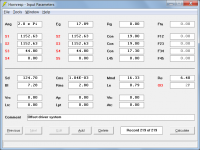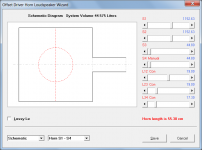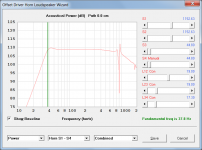Edit:
The auto copy seems to work on one of my computers, but not on the other?
I will try to do clean install on the one that does not work next time I'm on it.
The auto copy seems to work on one of my computers, but not on the other?
I will try to do clean install on the one that does not work next time I'm on it.
Last edited:
The auto copy seems to work on one of my computers, but not on the other?
I can't see how that can be possible. The auto copy code should be interpreted the same, regardless of the computer used.
I hear you loud and clear, just tried to reproduce the issue with no success.
The logical explanation would be that it's a classic PEBKAC situation, but I really did try several times and I got the same result every time, nothing has changed over the weekend except time has passed.
Now it's working.
Looking at wine shops in oz, trying to figure out if I can send you a case of something.
Sending you a single bottle of my homemade wine would be really expensive, and then I am worried it would somehow fail to get through customs. Just the thought of someone potentially pouring my wine down the drain, is an extremely effective deterrent.
The logical explanation would be that it's a classic PEBKAC situation, but I really did try several times and I got the same result every time, nothing has changed over the weekend except time has passed.
Now it's working.
Looking at wine shops in oz, trying to figure out if I can send you a case of something.
Sending you a single bottle of my homemade wine would be really expensive, and then I am worried it would somehow fail to get through customs. Just the thought of someone potentially pouring my wine down the drain, is an extremely effective deterrent.
The logical explanation would be that it's a classic PEBKAC situation
🙂.
Hello David.
I have a question regarding a comparison between Martin King's T-line calculations and the ones possible in Hornresp. A very knowledgeable friend of mine is starting a design for himself and I mentioned Hornresp as a great resource for such calculations. That is what i usually do when people ask me what I use for loudsdpeaker number crunching! Hornresp rules!
The question that got shot across my bow was how does Hornresp treat the speed of sound through a fibrous tangle? Martin King's claim is that he has figured this out and made appropriate calculations to make the simulation match the real world results. Has there been any verification of the model used in Hornresp for the speed of sound through a fibrous medium.
All I can see on the input screen is an adjustable air resistivity variable. Quite useful really, but possibly only part of the math that is potentially behind the resulting calculations.
I have a question regarding a comparison between Martin King's T-line calculations and the ones possible in Hornresp. A very knowledgeable friend of mine is starting a design for himself and I mentioned Hornresp as a great resource for such calculations. That is what i usually do when people ask me what I use for loudsdpeaker number crunching! Hornresp rules!
The question that got shot across my bow was how does Hornresp treat the speed of sound through a fibrous tangle? Martin King's claim is that he has figured this out and made appropriate calculations to make the simulation match the real world results. Has there been any verification of the model used in Hornresp for the speed of sound through a fibrous medium.
All I can see on the input screen is an adjustable air resistivity variable. Quite useful really, but possibly only part of the math that is potentially behind the resulting calculations.
All I can see on the input screen is an adjustable air resistivity variable. Quite useful really, but possibly only part of the math that is potentially behind the resulting calculations.
Hi Mark,
Hornresp uses the model developed by D. Keith Wilson, as documented in the Applied Acoustics paper titled "Simple, Relaxational Models for the Acoustical Properties of Porous Media", published in 1996.
Model Overview:
"The viscous and thermal dissipation of an acoustic wave propagating through a porous medium is shown to be characteristic of a relaxation process. Based on this interpretation, a new model for the complex density (dynamic permeability) and bulk modulus, which describe the viscous and thermal processes, respectively, is proposed. The model is based on approximating the relaxational characteristic, as opposed to previous models based on matching low- and high-frequency asymptotic behavior. An advantage of the relaxation model is that one fewer parameter is required. The relaxation model is also simpler than the commonly used Zwikker/Kosten/Attenborough or Biot/Allard models, in the sense that it contains no Bessel or Kelvin functions, and is not a modified form of the solution for uniform, circular pores. And unlike the Delany/Bazley empirical equations, the relaxation model is physically realistic for all frequencies."
As I understand it, Martin's model is more empirical, developed based on his own observations and experience.
Rest assured, the absorbent filling material model used in Hornresp is a very good one... 🙂.
Kind regards,
David
All I can see on the input screen is an adjustable air resistivity variable. Quite useful really, but possibly only part of the math that is potentially behind the resulting calculations.
I think I can answer this, since I recommended the paper that the model is based on in the first place 🙂 The paper is "Simple, Relaxational Models for the Acoustical Properties of Porous Media", Wilson, D. K., J. Sound Vibr., 1997, vol 50, pp. 171-188. This paper was recommended to me by T.E. Vigran, professor emeritus in acoustics at my former university. He has worked on porous absorbers and HVAC silencers for decades, and has a method to characterize materials which is very accurate. If he says the Wilson method fits well with measurements, I'm confident it does.
The method is based on treating the filling material as an "equivalent fluid", and basically finds the equivalent complex wave number (lossless case: k = 2pi*f/c) and characteristic impedance (lossless case: rho*c/S) for sound propagating through it. These can be found from the flow resistance alone, but if you can find parameters like relaxation times, tortouisity, and pore slant angle, you can probably determine them even more accurately. He uses the method in his software NorFLAG, and it is described in the manual (p24) together with other models.
As the wave number and characteristic impedance include sound speed, the sound speed through the material is implicitly modified. And it's a bit more involved than just modifying a number; the sound speed itself can be regarded as becoming a complex number.
I don't know if the model has been verified when used in Hornresp, for loudspeakers, but it has been extensively verified by direct measurements of porous absorbers. Some measurements are shown in the NorFLAG manual mentioned above. See page 58, for instance.
Thanks David and Bjørn. It's great to know the background to some of the hidden calculations. I think I will be helping a friend to design some T-lines. Something I have not touched in over 25 years. It will be an adventure!
2X RS180 in bass bin TL with HornResp sim
David, I posted this in Multiway yesterday - of course this is a better place, since it's really an HR question.....
I built a small(ish) MTM with 2x 4 inch drivers, and want to add a bass bin using 2X RS180 woofers in a TL. I'm getting a lot (too much) variation at Fb using Unibox, HornResp vented sim, and HornResp OD TL response.
I've used Unibox a lot, and it shows 2X RS180 in 46 liters with a 3" ID port that is 6.75 inch long (Fb/F3 35 HZ) with a flat response. Modeling the same (or very similar) in HornResp using a Vented wizard shows a very similar response, but modeling the same in a classic OD TL design with a port shows a large droop prior to Fb.
Obviously, I'm stumped. The sims use the same drivers, in similar boxes, with similar tuning, but a large difference in bass output.
David, I posted this in Multiway yesterday - of course this is a better place, since it's really an HR question.....
I built a small(ish) MTM with 2x 4 inch drivers, and want to add a bass bin using 2X RS180 woofers in a TL. I'm getting a lot (too much) variation at Fb using Unibox, HornResp vented sim, and HornResp OD TL response.
I've used Unibox a lot, and it shows 2X RS180 in 46 liters with a 3" ID port that is 6.75 inch long (Fb/F3 35 HZ) with a flat response. Modeling the same (or very similar) in HornResp using a Vented wizard shows a very similar response, but modeling the same in a classic OD TL design with a port shows a large droop prior to Fb.
Obviously, I'm stumped. The sims use the same drivers, in similar boxes, with similar tuning, but a large difference in bass output.
Attachments
-
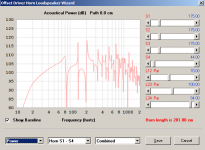 HR-46-liters-TL-w-port-power-output.PNG29.2 KB · Views: 110
HR-46-liters-TL-w-port-power-output.PNG29.2 KB · Views: 110 -
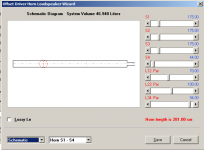 HR-46-liters-TL-w-port-schematic.PNG13.2 KB · Views: 109
HR-46-liters-TL-w-port-schematic.PNG13.2 KB · Views: 109 -
 HR-46-liters-TL-w-port-input-window.PNG19 KB · Views: 214
HR-46-liters-TL-w-port-input-window.PNG19 KB · Views: 214 -
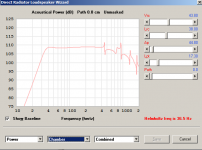 HR-2x-RS180-45-liter-vented-power-output.PNG23.1 KB · Views: 216
HR-2x-RS180-45-liter-vented-power-output.PNG23.1 KB · Views: 216 -
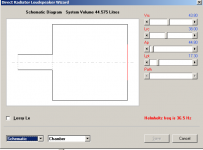 HR-2x-RS180-45-liter-vented-schematic.PNG12.1 KB · Views: 225
HR-2x-RS180-45-liter-vented-schematic.PNG12.1 KB · Views: 225 -
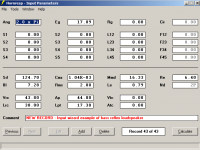 HR-2x-RS180-45-liter-vented-input-paramters.PNG19 KB · Views: 224
HR-2x-RS180-45-liter-vented-input-paramters.PNG19 KB · Views: 224 -
 2x-RS180-params-46-liters-35hz-fb.PNG54.5 KB · Views: 221
2x-RS180-params-46-liters-35hz-fb.PNG54.5 KB · Views: 221
The sims use the same drivers, in similar boxes, with similar tuning, but a large difference in bass output.
Hi joetekubi,
For the comparison to be valid, your offset driver system design needs to be as shown in Attachment 1. Adjusting L12 in the Loudspeaker Wizard will change the position of the offset driver. You will find that the actual position of the driver makes very little difference to the response at bass frequencies.
There will always be a slight difference in the fundamental resonance frequencies of the two systems because the Hornresp bass reflex design automatically includes an internal end correction on the port tube, whereas the offset driver design does not. For your test examples, the resonance frequency of the bass reflex design is 36.1 Hz and the resonance frequency of the offset driver design is 37.8 Hz.
Kind regards,
David
Attachments
Last edited:
You will find that the actual position of the driver makes very little difference to the response at bass frequencies.
Greets!
I consider this a bit misleading in that it can have a significant impact on vent design for a given Fb via increased damping when properly designed for it, which impacts the quality of its response.
Anyway, my responses to the original thread that apparently sent him here: 2X RS180 in bass bin TL with HornResp sim
GM
Greets!
I consider this a bit misleading in that it can have a significant impact on vent design for a given Fb via increased damping when properly designed for it, which impacts the quality of its response.
Anyway, my responses to the original thread that apparently sent him here: 2X RS180 in bass bin TL with HornResp sim
GM
Well, i needed help, and was not making progress.
Not dissing you in any way.
One of the interesting things is that suddenly HR "clicked" for me, and I now am not intimidated or unsure of what I'm doing. Neat. Long time coming.
I ran the MLTL sim yesterday starting from the input wizard, and got exactly the same results as my previous MLTL sim.
Puzzling.
It was the same thing that lead me to "currents and waves in fluids" theory.
Long BR/TL boxes behave a certain way, in some cases it is better to have several separate chambers, to get shorter distances between internal boundaries, so that unwanted resonances are pushed higher up.
But I'm probably spouting nonsense again.
Plenty of good science in fluids theory though.
Long BR/TL boxes behave a certain way, in some cases it is better to have several separate chambers, to get shorter distances between internal boundaries, so that unwanted resonances are pushed higher up.
But I'm probably spouting nonsense again.
Plenty of good science in fluids theory though.
Hi joetekubi,
For the comparison to be valid, your offset driver system design needs to be as shown in Attachment 1. Adjusting L12 in the Loudspeaker Wizard will change the position of the offset driver. You will find that the actual position of the driver makes very little difference to the response at bass frequencies.
There will always be a slight difference in the fundamental resonance frequencies of the two systems because the Hornresp bass reflex design automatically includes an internal end correction on the port tube, whereas the offset driver design does not. For your test examples, the resonance frequency of the bass reflex design is 36.1 Hz and the resonance frequency of the offset driver design is 37.8 Hz.
Kind regards,
David
Thanks David -- looks like you modeled a BR in a different fashion than the wizard. Your results are pretty identical to the HR BR wizard I ran as well as the Unibox model. I'll play your model - I'm really most interested in simming a MLTL for this project.
Well, i needed help, and was not making progress.
Not dissing you in any way.
One of the interesting things is that suddenly HR "clicked" for me, and I now am not intimidated or unsure of what I'm doing. Neat. Long time coming.
I ran the MLTL sim yesterday starting from the input wizard, and got exactly the same results as my previous MLTL sim.
Puzzling.
Understood, I'm not nearly as 'thin skinned' as some on the various forums, just Dave's response made it clear to me that 'we' were having a 'failure to communicate' and it's also obvious that if you play with the LW enough you'll probably eventually 'slide' your way into something that looks worthwhile building or copy one for a different driver, but if not or don't want to take the time, me or someone else will post one for you.
If you're interested enough to learn the fundamentals of acoustics and how to use them to design all manner of speaker alignments, then recommend immersing yourself in MJK's DIY oriented collected works complete with a yahoo HELP forum and of course here at DIYaudio also: quarter-wave.com
So, which way you want to go forward?
GM
I consider this a bit misleading
Sorry for any confusion - I was referring to the results seen in Hornresp.
- Home
- Loudspeakers
- Subwoofers
- Hornresp
